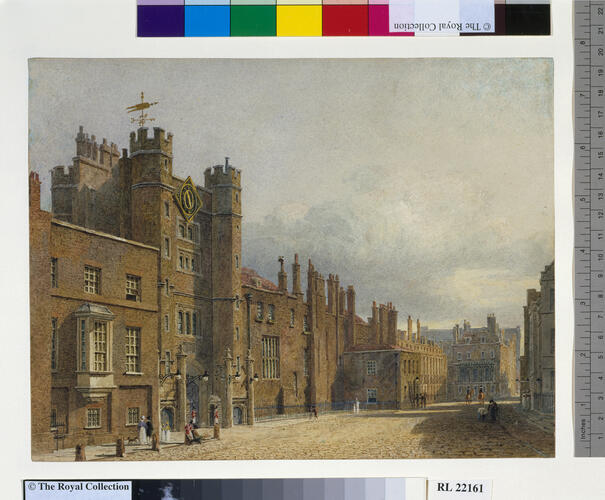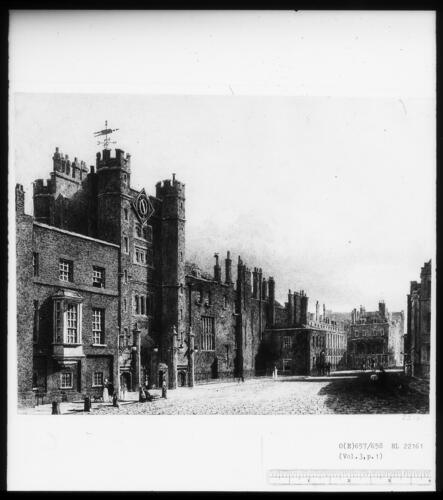Charles Wild (1781-1835)
St James’s Palace: The north front 1819
Watercolour with touches of bodycolour over pencil | 19.7 x 28.8 cm (sheet of paper) | RCIN 922161
-
In George III’s reign St James’s Palace was the ceremonial centre of court life. The main part of the palace - with the great gatehouse shown to the left of centre in this view - was built by Henry VIII, on the site of a leper hospital. Additional buildings, including those that continue in use as the State Apartments, were introduced by Christopher Wren for Queen Anne in the early eighteenth century. These apartments culminated in the great Drawing Room and Council Chamber (now the Entrée Room and the Throne Room) overlooking the south front of the palace. It was in these rooms that the formal levées, Drawing Rooms and audiences took place throughout the eighteenth century.
The royal cabinet-maker William Vile supplied much new furniture for the Queen’s rooms at St James’s in the early 1760s. However, in 1767 Mrs Lybbe Powys commented that ‘tis Impossible as it now is’ for the King to reside there in comfort as well as in state: hence the royal family’s increasing use of Buckingham House. There are descriptions of weekly concerts in the palace at this period, on which occasions the King and Queen performed alongside professional musicians. Levées took place on Wednesday and Friday mornings and were attended by men only; until the King’s illness in 1788, they also took place on Monday when Parliament was sitting. Drawing Rooms (which were open to both sexes) took place on Thursdays and Sundays and were attended by both the King and the Queen. These were the occasions at which new infant princes and princesses were first displayed to the public.
In January 1809 a fire destroyed a large portion of the buildings in the south-eastern part of the palace. According to Pyne, this included ‘the most interesting and picturesque part of the ancient structure, and comprehending the king’s and the queen’s private apartments . . . [and] some of the old state apartments . . . Since which event the palace has not been visited by their Majesties but on a few public occasions; the courts of late having been held at her Majesty’s palace of Buckingham-House, or at Carlton-House, the palace of his Royal Highness the Prince Regent’.In George III’s reign St James’s Palace was the ceremonial centre of court life. The main part of the palace - with the great gatehouse shown to the left of centre in this view - was built by Henry VIII, on the site of a leper hospital. Additional buildings, including those that continue in use as the State Apartments, were introduced by Christopher Wren for Queen Anne in the early eighteenth century. These apartments culminated in the great Drawing Room and Council Chamber (now the Entrée Room and the Throne Room) overlooking the south front of the palace. It was in these rooms that the formal levées, Drawing Rooms and audiences took place throughout the eighteenth century.
Catalogue entry adapted from George III & Queen Charlotte: Patronage, Collecting and Court Taste, London, 2004Provenance
Probably acquired by George IV
-
Creator(s)
Acquirer(s)
-
Medium and techniques
Watercolour with touches of bodycolour over pencil
Measurements
19.7 x 28.8 cm (sheet of paper)
Other number(s)
RL 22161Alternative title(s)
St James's Palace.










